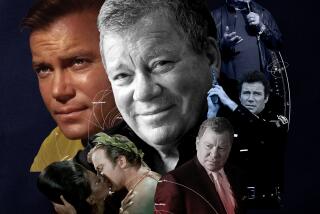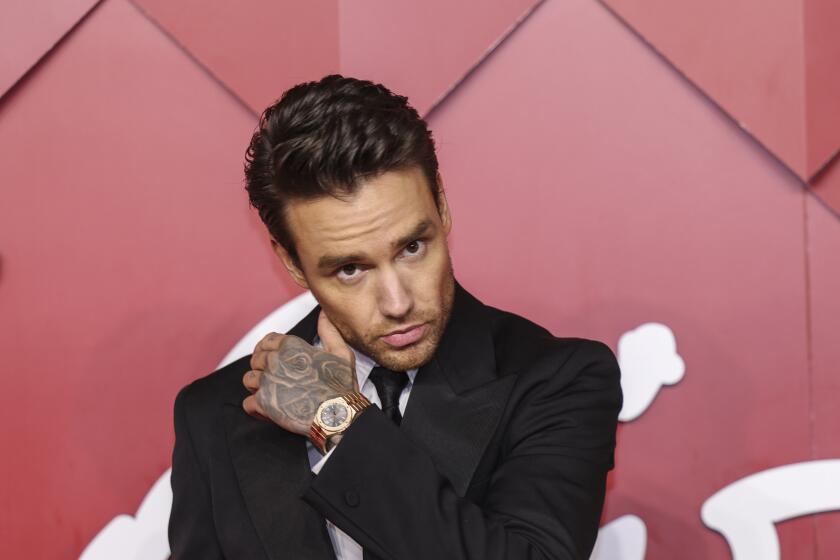These Teachers Are Music to Students’ Ears : Young Jazzmen Redman and Salvatore Inspire Master Class With Their Insights
“Who’s the teacher here?” whispered a surprised listener who casually wandered into a Master Class at USC’s Bovard Auditorium Tuesday afternoon.
It was a little hard to tell. On stage, young jazz tenor saxophone whiz Joshua Redman, 22, and even younger jazz piano prodigy Sergio Salvatore, 13, were offering bits and pieces of professional advice to a few hundred university and high school students. The atmosphere was warm and friendly--at times jovial and lighthearted--from an audience that saw nothing unusual about a pedagogical interaction with artists of their own, or perhaps a younger, generation.
For the record:
12:00 a.m. Nov. 11, 1994 For the Record
Los Angeles Times Friday November 11, 1994 Home Edition Calendar Part F Page 12 Column 2 Entertainment Desk 1 inches; 16 words Type of Material: Correction
Redman’s age-- Jazz saxophonist Joshua Redman’s age was incorrectly reported in Thursday’s Calendar. He is 25.
Both the questions and answers were direct and to the point.
“What do you think is the most important thing about your music?” asked one student.
For Redman, a 1991 Phi Beta Kappa graduate of Harvard, the university environment was not unfamiliar, even though his role in it was very new. Thoughtful and articulate, he pondered for a moment, holding his tenor saxophone in one hand as he propped a foot up on the conductor’s podium.
“To me,” he finally replied, “it’s communication. That’s what I think music is about. Whenever I step up to play, I’m trying to express myself, sure, but I’m trying to express myself to the people who are out there in the audience.”
*
Salvatore, dark-haired and long-legged, with the somewhat gawky look of a rapidly growing teen-ager, agreed. Still a junior high school student, his responses were a bit less detailed than Redman’s, but no less thoughtful.
“I think Josh is right,” Salvatore said. “I don’t think about it too much while I’m playing, but I like to know that I’m connecting with the listeners.”
Redman and Salvatore had opened the session with two easygoing jazz tunes, quickly establishing their musical credentials. As the class continued, they alternated question-and-answer segments with brief demonstrations of improvisation.
“What about your solos?” asked another student after both players had zipped through a medium tempo blues. “How do you approach them?”
“It’s kind of like a map,” Salvatore answered. “You have to find your way around the scales and see how they move. Improvising is like you know where you are, but you can go other places, because you have this destination in mind. And if you know where you are in the tune, then you can take a lot of different routes to get where you’re going.”
Redman, smiling at his younger colleague’s eloquence, nodded agreement before adding his own response.
“With improvisation,” he said, “I think there’s a fine line between being authoritative and obvious. I like to see one continuous stream from beginning to end in an improvisation--not just a sampling of what somebody can do in a solo. Some solos sound like the player’s trying to fit as much as they can do into every chorus. But to me, each solo is a different narrative, with a line that runs from beginning to end.”
“Is that hard to do?” asked another student.
“You better believe it,” Redman responded.
The USC Master Class was one part of a full day of events at Bovard Auditorium. Earlier, Redman and Salvatore had performed as soloists with the American Jazz Philharmonic at a morning concert for 1,700 students bused in from the Los Angeles Unified School District. In the evening, the philharmonic event was repeated for a free community concert.
*
The program, conducted by Jack Elliott, the ensemble’s permanent music director and principal guiding light, included works by Henry Mancini and Dave Grusin, as well as the West Coast premiere of “3 Shades of Blue,” a work for saxophone and orchestra composed by John Clayton. The crowd was active, enthusiastic and, at times, in Redman’s description, “boisterous.”
Somewhat restless during the music’s quieter passages, the young listeners came to life with Redman’s funky, audience-arousing cadenzas in the Clayton work.
“Man, that Josh Redman is too cool,” said one student, bobbing her head in rhythm and shouting encouragement as the saxophonist dug into a sequence of alternating honks and high notes.
“These kids really get into it,” said Elliott after the concert. “We’ve seen quiet audiences, and we’ve seen loud ones. But either way, they’ve all been enthusiastic.”
The daylong event was part of a 12-week schedule of performances by 24 Grammy-winning artists in 10 cities for the second annual American Express Gold Card Grammy Festival. Among the many artists appearing in Atlanta, Boston, Chicago, Dallas and elsewhere were Van Cliburn, Kenny Rogers, Vince Gill, Indigo Girls and Lyle Lovett.
As the Redman-Salvatore Master Class continued, and teachers and students became more relaxed, the questioning turned toward more personal matters.
“Would you like to have Branford Marsalis’ gig on the ‘Tonight Show’?” asked one student of Redman.
“An emphatic ‘no’ on that one,” he replied. “That’s not to say the money wouldn’t be nice. I grew up very poor, but I’m making a good living doing what I love to do, and that’s enough for right now. Sure, if somebody handed me that money Branford’s making to continue doing what I’m doing now, I’d say, ‘great.’ But nobody’s going to do that.”
Then, in a question directed at Salvatore: “How does it feel to be so young, and be playing with much older musicians?”
Salvatore laughed, then shrugged, “Well, the only time it’s really a problem is when we have to pick out what tune to play. I mean, you have to remember that I don’t have a third or even a fourth as much experience as some of the guys I play with. So I just don’t have that large a repertoire.”
*
As if in confirmation, the duo decided to do another tune. After choosing “Autumn Leaves,” Redman kicked off the theme, only to have Salvatore respond in a totally different key. Players and audience broke up in laughter. After a hurried conference to determine the appropriate key, Redman finally said, “Just go ahead and start. I’ll find it.”
And he did. When the piece ended, Redman was asked how he had made such a quick shift of gears.
“I don’t like to let thinking get in the way of the music,” he replied. “Usually, if I can hear it, I can play it, so I don’t give much thought to keys and structure, and so forth. I just try to let the music happen.”
The Master Class came to a close as a final questioner asked how Salvatore, an eighth-grader at his home in New Jersey, managed to keep up with his studies while he was on tour.
“Come on up to my room,” the young pianist replied, “and I’ll show you an 80-pound backpack filled with books. I’ve got more than enough schoolwork to keep me busy until I get back to school.”
It was a fitting conclusion for an event that was as much about education, interaction and communication as it was about music.
“I’m not so sure about all this,” Redman had said shortly before the class began. “I’m really just a beginner. And I’m not sure I feel comfortable teaching people about music. Especially since many of them are my age, or even older.”
But by the time the class was over, the youthful Redman and Salvatore had illustrated, verbally and in performance, that talent and imagination have nothing to do with age, and that teaching can take place in many different ways.
More to Read
The biggest entertainment stories
Get our big stories about Hollywood, film, television, music, arts, culture and more right in your inbox as soon as they publish.
You may occasionally receive promotional content from the Los Angeles Times.










